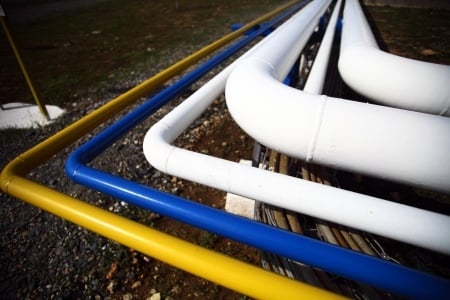Adopting and maintaining proper color codes for treatment plant piping systems according to ANSI guidelines can help you avoid potential operational errors and workplace accidents by allowing your staff to identify the contents of all pipelines easily, quickly, and accurately. Though standard piping color codes have been developed for water and wastewater treatment plants, not all plants follow the same recommendations, causing a great deal of confusion. To clarify the procedural aspects relating to color coding standards for treatment plant piping systems, we’ll use this blog post to review the recommended identification color codes along with a summary of instructions.

Color Coding Standards for Treatment Plant Piping Systems
All new and modified treatment plant piping systems should be color coded according to the following scheme:
Water Lines
Olive Green raw or recycled water
Light Green non-potable water
Aqua settled or clarified water
Dark blue finished or potable water
Waste Lines
Light Brown backwash waste
Dark brown sludge
Dark grey sewer
Chemical Lines
White ammonia
Black carbon slurry
Orange alum / primary coagulant
Yellow chlorine
Yellow with Violet Band chlorine dioxide
Yellow with Orange Band ozone
Yellow with Red Band sulfuric acid
Yellow with Green Band caustic
Light Green lime slurry
Light Green with Yellow Band sulfur dioxide
Light Green with Red Band phosphate
Light Green with Orange Band soda
Light Blue with Red Band fluoride
Orange with Green Band coagulant aids
Violet potassium permanganate
Other Lines
Red gas
Dark Green compressed air
Light gray other lines
General Instructions for Proper Color Coding of Treatment Plant Piping Systems
To ensure a precise, easy, and rapid identification of the gases or fluids flowing through piping systems, the following guidelines should be considered:
- For gases or liquids not listed above, it’s advisable to use a unique color scheme. When two similar colors are selected (e.g. light gray and medium gray), a six-inch band of a contrasting color should be applied to one of the pipes/systems (e.g. light gray with white band). Additionally, the name of the substance should be written on the pipeline.
- When different coating systems are used, it’s important to choose a uniform color.
- Appropriate stenciled marking should be used in conjunction with color coding standards. Specifically developed to indicate unit numbers, stenciled markings should contrast with the background color.
- Stenciled markings should include numbers along with flow abbreviations and arrows to indicate the flow direction where necessary (e.g. in areas where pipes pass through walls, at intersections, etc.).
Though modern treatment plant piping systems are made of different materials, metal remains one of the most common options. Metal pipes can be made of stainless steel, cast iron, copper, brass, or different alloys. The characteristics of individual metals or alloys, the type of fluid or gas flowing through the pipeline, and the environmental conditions must be carefully assessed prior to selecting protective coatings for specific piping systems. In addition, the treatment plant piping systems must comply with all applicable safety guidelines to ensure the safety of plant personnel.
For recommendations on the most appropriate protective coatings for treatment plant piping systems, feel free to contact our office in Jacksonville, Florida, at (904)-641-4800. At Performance Painting, our professional painters can take care of all your painting needs.






